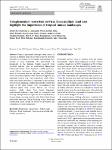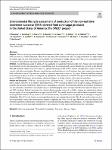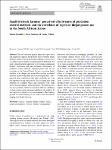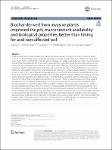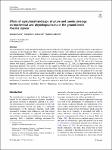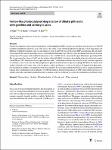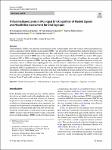Search
Author
- Osman, Ahmed I. (5)
- Chen, Zhonghao (2)
- Ricohermoso III, Emmanuel (2)
- Wang, Yongbin (2)
- next >
Subject
- LCA (6)
- ICP-MS (3)
- Artificial intelligence (2)
- CDW (2)
- next >
Date issued
Has File(s)
- true (220)
Search Results
Voluntary sustainability standards are quickly gaining ground. Whether and how they work in the field, however, remains largely unclear. This is troubling for standards organizations since it hinders the improvement of their standards to achieve a higher impact. One reason why it is difficult to understand the mechanics of VSS is heterogeneity in compliance. We apply machine learning techniques to analyze compliance with one particular VSS: Rainforest Alliance-for which we have detailed audit data for all certified coffee and cocoa producers. In a first step, we deploy a k-modes algorithm to identify four clusters of producers with similar non-compliance patterns. In a second step, we match a large array of data to the producers to identify drivers of non-compliance |
Tropical agricultural landscapes often consist of a mosaic of different land uses, yet little is known about the spectrum of ecosystem service bundles and materials they provide to rural households. We interviewed 320 households on the different benefits received from prevalent land-use types in north-eastern Madagascar (old-growth forests, forest fragments, vanilla agroforests, woody fallows, herbaceous fallows, and rice paddies) in terms of ecosystem services and plant uses. Old-growth forests and forest fragments were reported as important for regulating services (e.g. water regulation), whilst fallow lands and vanilla agroforests as important for provisioning services (food, medicine, fodder). |
There is increasing concern about the detrimental health effects of added sugar in food and drink products. Sweeteners are seen as a viable alternative. Much work has been done on health and safety of using sweeteners as a replacement for added sugar, but very little on their sustainability. This work aims to bridge that gap with a life cycle assessment (LCA) of sucralose derived from cane sugar grown in the United States of America (USA).
Methods |
The use of plastics in products and packaging is growing. At the same time, the lifespan of packaging is short and consequently plastic waste volumes are growing in Finland and globally. Although separate collection and recycling of plastic packaging waste exists in Finland, it needs to be strengthened to reach the European Union’s targets. The separately collected plastic waste is mechanically recycled, but the recycling capacity is small, as is the process’s yield of secondary polymers. Hence, a large share of plastic packaging waste remains being recovered for energy. In our study, we first apply material flow analysis (MFA) to identify different routes of plastic packaging waste in Finland, and then we apply life cycle assessment (LCA) to quantify greenhouse gas (GHG) emissions ... |
The use of poison against predators is pervasive and negatively impacts biodiversity and ecosystem health globally. Little is known about the correlates of poison use as a lethal control method on small-livestock farmland. We used a mixed-methods approach to investigate commercial farmers’ experience with and perceived effectiveness of predation control methods, reported poison use and its correlates in the Central Karoo. Farmers perceived lethal methods to be cheaper and more effective than non-lethal methods in protecting their livestock from predation. They reported more experience with lethal methods, and over half reported having used poison. |
Rapid development in industrialization and urbanization causes serious environmental issues, of which acid rain is one of the quintessential hazards, negatively affecting soil ecology. Liming has been investigated for a long time as the most effective amendment to alter the adverse effects of soil acidity resulting from acid rain. Herein, this study tested the biochar produced from invasive plants as an alternative amendment and hypothesized that biochar can maintain better availability of macronutrients under acid rain than liming by improving soil chemical and biological properties. Therefore, a pot experiment was conducted to compare the effects of lime and biochar at two rates (1% and 3%) on soil available nitrogen (N), phosphorous (P) and potassium (K) under simulated acid rain... |
The intensifications in the agricultural landscape and the application of pesticides can cause adverse effects on the fitness of organisms in that landscape. Here, we investigated whether habitats with different agricultural pressures influenced acetylcholinesterase (AChE) activity – a biomarker for exposure to pesticides, respiration rate, and resistance to starvation in the ground beetle Poecilus cupreus. Two differently structured landscapes were selected for the study, one dominated by small (S) and another by large (L) fields. Within each landscape three habitat types were selected: in the S landscape, these were habitats with medium (M), small (S) and no canola (meadow, 0) coverage (i.e., SM, SS, S0), and in the L landscape habitats with large (L), medium (M) and no canola (me... |
Detailed investigation of photocatalyzed degradation of dibutyl phthalate (DBP), an endocrine disrupter, in the presence of α-FeOOH (goethite) and different carboxylic acids is the focus of this study. To get a better insight into the efficiency of the degradation, the influence of different parameters, such as concentration of total Fe and Fe(II), dissolved oxygen, DBP concentration, pH and salinity is investigated. The reaction mechanism consists of several interrelationship steps. The first step is the chemical reaction of carboxylic acid groups of the organic acids with hydroxyl groups of the α-FeOOH and a charge transfer upon illumination generating Fe(II). |
Members of the Gulf Cooperation Council countries Bahrain, Kuwait, Oman, Qatar, Saudi Arabia, and the United Arab Emirates rely on desalination to produce water for domestic use. Desalination produces brine that may intrude into the aquifers to pollute the fresh groundwater because of the concentration gradient and groundwater pumping. Modeling the trends of saltwater intrusion needs theoretical understanding and thorough logical experimentation. The objective of this exercise was to understand the phenomenon of saltwater intrusion using an existing set of data analyzed with the convective–diffusion equation and the two-region mobile–immobile solution model. |
Trihalomethanes (THMs) are generated in the drinking water treatment plant, due to the reaction of the halogenated disinfection compounds with the natural organic matter (NOM). They are related to health problems both from the point of view of cancer development and other important diseases. This study aimed to assess the quality of tap water in Madrid in terms of prevention and control of THMs risks in the supply water treated by Canal de Isabel II (CYII) in a total of 108 samples throughout 2015 to 2020, to distinguish the problems of the different 21 districts or types of buildings, the seasonality and to estimate the risk of exposure to THMs from tap water in the population of Madrid. |


